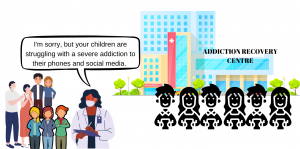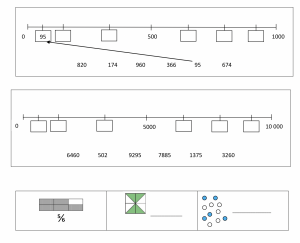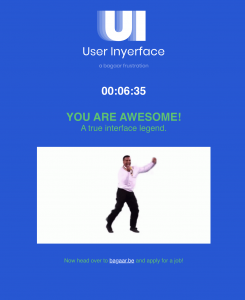
Final Project: User Experience and Changing Literacies


My journey through Text Technologies: The Changing Spaces of Reading and Writing

Dystopian: Child Addicts

Utopian: Deletion of Social Media
In a utopian world, all social media as we know it now, would be gone. The applications would be given a complete redesign, to be used purely for communication, connection, and the bettering of society. The apps would be void of all the garbage that makes the platforms so addictive and detrimental to mental health and wellbeing.
My bag was a digital bag with digital things and Tanya’s bag was a physical bag with physical things. I related to absolutely everything in Tanya’s bag, as I carry very similar things- cleaning products, snacks, receipts, writing objects, lip balm… these all travel with me out of the house. I giggled when I saw the Post-It notes, because those are in my top 3 favourite office supplies.
Reflecting on my original post, I never mentioned why I chose a digital bag over a physical bag. When I first read the assignment I was excited, because I remembered this trend on social media, but I never participated in it back then. At the time of the original assignment, I was working from home and didn’t need to commute to my office, and I had recently emptied my purse and only carry a tiny zip wallet with my phone and keys. I thought about curating a photo of what would normally be in my purse but decided that I wanted something natural and real… so digital bag was chosen.
“The two items that I think might stand out the most to an archeologist would be the mask and the sanitizer. These items would gives hints about living in a pandemic.”
Many of my classmates have posted photos with masks and hand sanitizer, giving the viewer context clues, such as approximate year and conditions. My digital bag, on the other-hand, has no indication of living in a pandemic at all, unless you count the large number of food and grocery delivery apps.
When I looked through Melissa’s emoji story, I immediately thought it was SuperSize Me, and I thought I was for sure right when I quickly browsed the comments and saw that another student had also guessed that. The actual solution is a Disney movie called Heavyweight, which I have never seen, so I wouldn’t have been able to guess it anyways. Even if Melissa had just put the title as emojis and then physically written out the entire plot of the movie, I still wouldn’t have been able to guess the name of the movie. At first, I looked at the title and did what her brother did, and thought it was a movie called “burger man.” Using emojis as symbolic representations is really difficult, as everyone has different interpretations of emojis and their meanings.
“Since we interpret and understand some symbols differently, it would be extremely difficult to communicate simply via symbols as this task demonstrates unless there was a widespread rule or understanding about what each symbol fundamentally means.”
This made me smile, because I instantly thought about Math when I read this sentence. Math is the same in every language, as it uses universally understood symbols. I experienced the power of math as a language when I had English Language Learners in my classroom. I had to try to assess what level of understanding they were at, and my district had created an ELL non-verbal assessment, which got rid of any words and focused only on diagrams, symbols, and numbers.
Here is an example of an assessment for Level D, which relates to Grade 3/4 outcomes.
What I like about these types of questions, is that words are not needed to communicate the next steps. All that is needed for a student to begin is one completed example, and the rest of the task becomes apparent.
For this task, like Ellen, I chose to create a manual script. I am immediately struck by the preciseness of Ellen’s writing, and how perfect each letter is. I can tell that she has taken her time to carefully and purposefully construct each letter. Although we are both drawn to cursive writing, I mention that I appreciate that it is faster than printing, whereas cursive allows Ellen to slow down and be mindful of her writing. This difference could be related to the differences of where we were constructing our scripts. Ellen was in her Dad’s office and was using a yellow pad of paper that had sentiment attached to it. I was laying on my bed, headphones in with lo-fi beats, writing in my familiar leather bound journal.
Ellen also mentions that she finds the task “unusually calming,” which resonates with me. I have a daily journaling practice, as it allows me to focus on myself, connect, and settle my mind.
I wonder how many of my students actually know how to write in cursive, and can they read cursive writing? Do my students journal? If they do, do they do it by hand? Or is their journal simply a collection of saved Snapchat stories, memes, and TikToks?
Nataliia Kudryk used Microsoft voice to text as her selected tool, just as I did. Nataliia mentioned that she was getting distracted and frustrated by the errors showing up on her screen. When I dictated my story, I chose to not look at the screen while I was dictating, because I knew I’d have the urge to correct mistakes as well!
It was interesting reading her discussion about native and non-native speakers and how her “organs of speech have not been trained to speak English,” resulting in errors in dictation. This made me think about how English Language Learners use assistive technology, and if the benefits outweigh the difficulties. This lead me to a study discussing the use of word prediction software with bilingual learners in early childhood. Throughout the process, students increased their confidence in reading and writing, expanded their vocabulary and responses, and developed various new literacies (Brown & Allmond, 2021). This software should not be seen as something that encourages kids to cheat; instead it should be looked at as a tool to enhance their learning and development.
References
Brown, S.,& Allmond, A. (2021). Emergent bilinguals’ use of word prediction software Amid Digital Composing. The Reading Teacher, 74(5), 607-616. https://doi.org/10.1002/trtr.1988
In my Network Assignment post, I mentioned that I would check out Teri-Lynn and Michael‘s experiences with choosing their lists for the Golden Record. There is one criteria that we all base our lists on, and that is diverse representation- all of us wanted to be able to represent various cultures through our list. Interestingly, Teri-Lynn and Michael both based their selections off of time periods, whereas I ignored that completely. Teri-Lynn mentions that she has no expertise in music, where I grew up in a very musical household, so I could choose my criteria quite differently.
I think it is SO interesting that Michael based his songs off of the most current information, rather than a holistic view:
“I want songs that tell me what their life, culture and planet are currently like… I want to know what is happening now, not who is a historical figure (that can come later).”
I never thought of it like this at all, and I so appreciate this different perspective. Because the golden record is just a snapshot summary into what it’s like on Earth, it makes sense to show the present rather than the past; if we ever make contact with anything/anyone in space, then they can definitely sit down for a History lesson or two once they come visit…
I thoroughly enjoyed reading Connie Sim’s Twine post, especially how her daughter was involved! Research has found that when girls engage in the creation of Twines, there is increased interest in writing tasks as well as increased engagement in a participatory culture (Tran, 2016).
Connie and I had very different creation processes. My Twine had a singular story line and Connie’s had more and different paths/plots to follow. I began my story by mapping it out, and she mentioned that it would have been easier if she had done this initially. One of the first things Connie noticed was a black background with white text, and began exploring colours and formatting; the first thing I did was input my text and connections. Because this was my first time using Twine, I wanted to slow myself down and focus on the content rather than the extras. That being said, I do love how Connie included photos and borders in her Twine; this is something that I mentioned in my initial reflection that I would like to explore more of.
I appreciate the link to the cheat sheet for Twine that Connie shared. I also utilized outside resources, but immediately went to YouTube for guidance rather than looking at static websites. I learn best by watching, listening, and then doing, so having a YouTube tutorial on one screen and my work on the other means I am able to pause, rewind, and look for further help as needed.
References
Tran, K. M. (2016). “Her story was complex”: A Twine workshop for ten- to twelve-year-old girls. E-Learning and Digital Media, 13(5–6), 212–226. https://doi.org/10.1177/2042753016689635

For this task, I wanted to record myself struggling through this site, with my comments in real time, followed by a reflection of my experience.